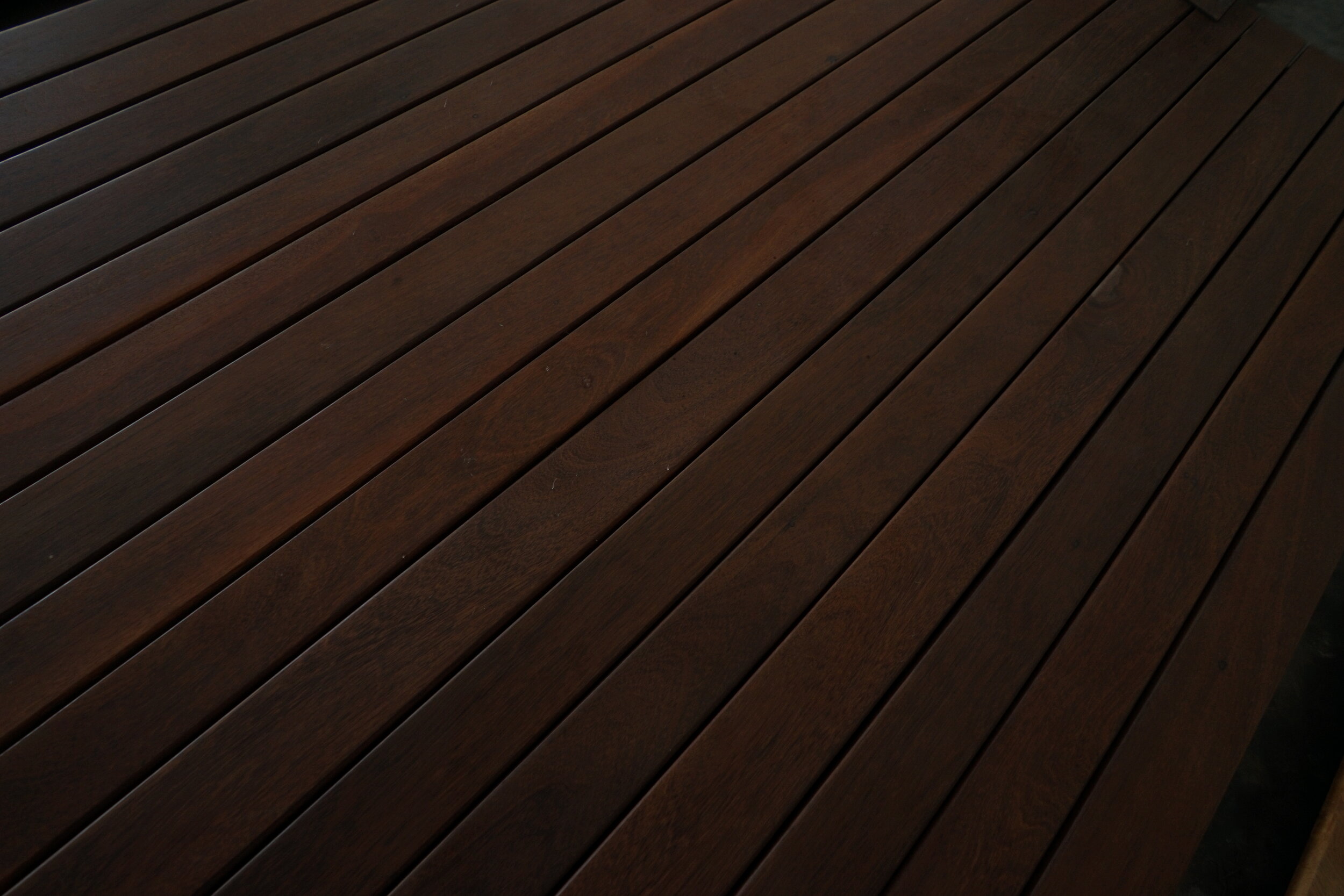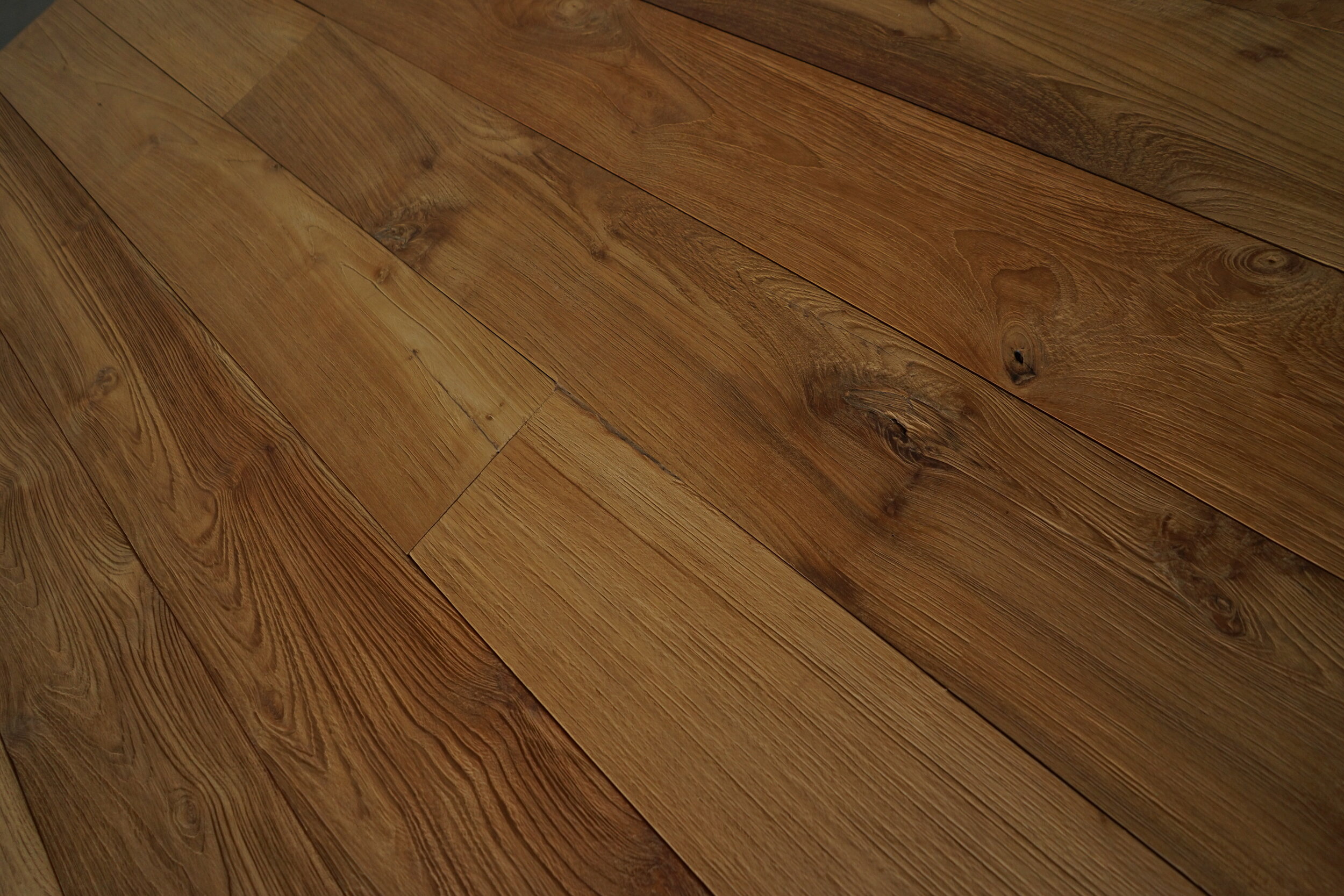Our reclaim Ulin ironwood and hardwood
Kaltimber provide a certified 100% recycled Ulin ironwood supply to every single wood lover.
We are carefully reclaiming from disused structures and work in close relation with the Forest Ministry to ensure a fully legal wood supply ready for local sale as well as export.
With extremely competitive price Kaltimber is making sure no wood lover is left behind, from small private project to hotels and nationwide distributors.
Ulin decking smooth natural finish
Our specialty, Ulin Kalimantan!
We are specialized in reclaiming ironwood from Kalimantan. All our wood comes from legal and verified sources, and we transform it, for the most part, into decking and flooring.
More information can be found in the categories Decking and/or Flooring.
More about Ulin
Ulin is a remarkable wood. It's extremely slow growth rate at less than 0.5mm a year results in a highly dense wood ideal for exterior applications. Ulin is a rare tree native to Indonesia. It is threatened by habitat loss.
The government of Indonesia and the state government of Sarawak have formally banned the export of this species. Illegal smuggling continues to be a major problem. It grows in lowland primary and secondary forest up to 625m altitude. It is commonly found along rivers and adjacent hills. It requires an average annual rainfall of 2500–4000 mm.
This very important tree is one of the most durable and heaviest timbers in the world. Ulin trees can grow to attain over 1,000 years of age. Common commercially exploitable trees attain a height of 30 or more metres (100 ft) with trunk diameters of exploitable trees up to 92 cm (36 inches).
Trade & local names: Borneo ironwood, billion, belian, biliran, Kalimantan ironwood
Found in: Indonesia, East Malaysia, Philippines
Qualities: Growth ring boundaries indistinct or absent. Heartwood basically brown to yellow, without streaks. Sapwood colour distinct from heartwood colour. Odor has faint lemon scent. Heartwood with yellowish to greenish (olive) hues when fresh, dark brown to almost black upon exposure.
Density: 0.85–1.1 g/cm³
Durability: Class 1
Uses: Heavy engineering, ulin ironwood decking. Due to the excellent resistance to bacterial, fungal, insect and marine borer attack the wood is highly prized for many outdoor uses. Internationally, it is renowned for heavy construction such as a buffer between transportation trailers and heavy steel fabrications (such as boilers, pressure vessels, reactors and many others). It is also frequently found in dry docks as a timber to separate the hull of ships from the steel supporting stands. Can be used on exposed flooring.
Status: Listed as vulnerable by the IUCN (World Conservation Union). The species is threatened by over-exploitation, predominantly by illegal loggers. Current demand for the timber is fueled for its esteem among Chinese as a coffin wood (as it is resistant to insect and rot). Included in list of vanishing timber species of the Philippines and considered almost extinct in Sabah. In Java and Sumatra it exists solely in National Parks. Currently the situation is assessed as a serious depletion of stands.
Teak flooring wirebrushed
Partner product, Teak.
Reclaimed Hardwoods from Kitaru Lumberyard
Located just a short distance from our main site in Bali, our trusted partner, Kitaru Lumberyard, specializes in reclaiming premium tropical hardwoods from East Kalimantan and Central Java. All wood is legally sourced, verified, and expertly repurposed for sustainable use in decking, flooring, cladding, and bespoke joinery projects.
More about our wood species
Teak (Tectona grandis)
Teak is a legendary hardwood prized for its golden-brown hue, high oil content, and unmatched durability. Naturally resistant to water, termites, and decay, it’s a preferred choice for marine applications, outdoor furniture, and luxury architecture. Over time, untreated teak develops a graceful silver-grey patina. Native to Southeast Asia, teak remains a sustainable option thanks to regulated plantations in Indonesia and beyond.
Bangkirai (Shorea laevis)
Also known as Yellow Balau, Bangkirai is a dense, heavy-duty hardwood ideal for outdoor use. Its natural resistance to rot, fungi, and pests makes it perfect for decking, docks, and high-traffic exterior spaces. With a golden to deep honey tone, Bangkirai brings both strength and beauty to any project, aging into a weathered grey without compromising structural integrity.
Kapur (Dryobalanops lanceolata)
Kapur is a reddish-brown hardwood known for its strength, termite resistance, and versatility. Often used in both structural and decorative applications, it's ideal for roofing frameworks, exterior cladding, and interior flooring. Its balanced density makes it easy to work with, while its natural durability ensures longevity in exposed environments.
Meranti (Shorea spp.)
Meranti offers rich, warm tones and fine grain, making it a favorite for interior design, cabinetry, and paneling. Lightweight yet structurally sound, this species blends aesthetic appeal with everyday performance. Available in red, yellow, and white varieties, reclaimed Meranti delivers a sustainable and elegant solution for high-end joinery and decorative finishes.
For more information or to request detailed wood data sheets, feel free to contact us or follow this link to reach Kitaru Lumberyard directly.
Picture by Kaltimber taken in East Kalimantan while surveying on the Sungai Mahakam
Ulin Ironwood: An In-Depth Guide to This Unique and Valuable Hardwood
Introduction to Ulin Ironwood
Ulin ironwood, scientifically known as Eusideroxylon zwageri, is one of the most remarkable and valuable tropical hardwoods found in Southeast Asia, particularly in the rainforests of Borneo and Sumatra. Known for its extreme durability and resistance to environmental factors, Ulin ironwood is often referred to as "Bornean ironwood" or "kayu besi" (ironwood) in Indonesia, and it has earned a legendary status among builders and artisans for its strength and longevity.
Botanical Characteristics and Growth
The Ulin tree is an evergreen species that belongs to the family Lauraceae. This species is monotypic, meaning that it is the only species within the genus Eusideroxylon. Ulin trees can reach towering heights of up to 50 meters (164 feet), with diameters that can exceed 2 meters (6.5 feet). The tree has a straight bole that is usually host to a parasitic vine called Cassytha, with leaves reduced to scales, often extending up to half of the tree's height. The trunk often displays small, rounded buttresses at the base, giving it an appearance reminiscent of an elephant’s foot. These features make the Ulin tree one of the giants of the Southeast Asian rainforest.
Leaves and Flowers: The leaves of the Ulin tree are dark green, simple, and leathery, with an elliptical to ovate shape measuring 14–18 cm long and 5–11 cm wide. These leaves are glossy due to a waxy coating, and young leaves exhibit a reddish-brown to yellowish-red hue. The flowers of the Ulin tree are pale yellow and hermaphroditic, featuring six tepals and an actinomorphic structure, meaning they are radially symmetrical. Pollination is primarily carried out by bees and other insects, while its fruits, which are drupes, are dispersed by vertebrate animals such as birds, monkeys, bats, and rodents.
Habitat and Ecology
Ulin ironwood thrives in lowland tropical rainforests and is commonly found in valleys, hillsides, and low ridges where there is sufficient soil moisture, ranging from sea level up to elevations of 625 meters. This species prefers partial shade in its early years but requires abundant sunlight as it matures. Ulin trees are a significant component of primary forests, contributing to the forest canopy. The slow growth rate of the Ulin tree, with an average radial growth of just 0.058 cm per year, reflects its adaptation to the nutrient-poor soils and competitive environment of the tropical rainforest.
Conservation Status and Efforts
The Ulin tree is currently listed as vulnerable on the IUCN Red List, primarily due to overexploitation and habitat loss. Extensive logging over the past decades has significantly reduced the population of mature Ulin trees, making them increasingly rare in their natural habitat. The government of Indonesia, along with the state government of Sarawak in Malaysia, has implemented bans on the export of Ulin wood to curb illegal logging and promote conservation efforts. However, illegal logging and smuggling remain significant threats to the species, necessitating stringent enforcement and sustainable management practices.
Conservation efforts are critical for ensuring the survival of Ulin ironwood. Initiatives include the establishment of protected areas such as national parks and reserves, where logging is strictly prohibited. In addition, sustainable forestry practices, including selective logging and replanting, are being promoted to balance the economic benefits of Ulin wood with the need for conservation.
Properties of Ulin Ironwood
Ulin ironwood is prized for its exceptional physical properties:
Durability: The heartwood of Ulin is renowned for its extreme durability and resistance to decay, insects, and marine borers. It has a service life of up to 100 years even in direct soil contact and more than 20 years in tropical marine environments, making it ideal for both terrestrial and maritime applications.
Density and Hardness: Ulin wood is incredibly dense, with a fine and even texture. It is resistant to termites and other wood-boring insects, which contributes to its longevity. The high density of the wood makes it heavy and challenging to work with, but this also ensures its robustness and durability.
Resistance to Environmental Factors: Ulin ironwood is highly resistant to changes in temperature, humidity, and the corrosive effects of seawater. This resistance makes it an excellent choice for outdoor and marine applications, where it can withstand harsh environmental conditions without deteriorating.
Aesthetic Qualities: The wood of Ulin is naturally glossy and has a pleasant lemon scent when freshly cut. Over time, the wood darkens from a light brown to a deep reddish-brown or nearly black, adding to its aesthetic appeal. The grain is typically straight, but it can also be slightly interlocked, giving the wood a distinctive appearance.
Uses of Ulin Ironwood
Due to its remarkable properties, Ulin ironwood has a wide range of uses:
Construction: Ulin wood is extensively used in construction, particularly in areas with high moisture levels, such as Kalimantan. Traditional houses in these regions are often built entirely from Ulin wood, including the roof shingles, which are known as "atap sirap." The wood's resistance to decay and termites makes it an ideal material for building homes that last for generations.
Maritime and Industrial Applications: Ulin wood's resistance to marine borers and other environmental factors makes it highly suitable for maritime construction, including shipbuilding, dock construction, and wharfs. It is also used in heavy industrial applications, such as railway sleepers, power line poles, and industrial flooring.
Furniture and Decorative Items: The fine grain and natural luster of Ulin wood make it a popular choice for high-quality furniture and decorative items. Its ability to take on a high polish enhances its appeal for use in fine cabinetry and specialty woodcrafts.
Cultural and Traditional Uses: In addition to its practical uses, Ulin wood holds cultural significance in many communities. It is often used to make traditional tools, weapons, and ceremonial objects, reflecting its importance in local customs and traditions.
Challenges and Sustainability of Ulin Ironwood
The increasing rarity and high demand for Ulin ironwood have raised significant sustainability concerns. Overharvesting and illegal logging have depleted many natural stands of Ulin, and the slow growth rate of the species means that it cannot easily recover from heavy exploitation. To address these challenges, several measures are being implemented:
Sustainable Forestry Practices: Sustainable forestry practices, including selective logging and controlled harvesting, are crucial for the conservation of Ulin ironwood. By limiting the number of trees cut and ensuring that young trees are allowed to mature, these practices help maintain healthy forest ecosystems and ensure the continued availability of Ulin wood.
Regulations and Enforcement: Strict regulations and enforcement are necessary to combat illegal logging and ensure that Ulin wood is harvested sustainably…if sustainable harvest is even possible in the first place! Governments and environmental organizations are working together to monitor forests, enforce laws, and promote sustainable management practices.
Community Involvement: Engaging local communities in conservation efforts is essential for the success of sustainability initiatives. By involving communities in forest management and providing economic incentives for sustainable practices, conservation programs can help protect Ulin ironwood while supporting local livelihoods.
Conclusion
Ulin ironwood is a truly unique and valuable hardwood with a rich history and a wide range of applications. Its exceptional durability, resistance to environmental factors, and aesthetic qualities make it highly sought after for construction, maritime use, and fine woodworking. However, the increasing rarity of Ulin wood and the challenges associated with its conservation highlight the need for sustainable management practices and effective enforcement of regulations. By balancing the economic benefits of Ulin wood with the need for conservation, we can ensure that this remarkable species continues to thrive in its natural habitat for generations to come.
Explore More about Ulin Ironwood
For more information on Ulin ironwood and sustainable forestry practices, visit our website or contact us directly. Together, we can work towards a more sustainable future for this incredible resource.
Photo by Kaltimber
Kenapa Harus Memilih Kayu Ulin Bekas?
Kayu Ulin Kalimantan dikenal sebagai kayu terbaik untuk berbagai kebutuhan konstruksi. Dikenal karena kekuatan, ketahanan terhadap air, dan serangga, kayu Ulin adalah pilihan unggul di dunia konstruksi. Namun, seiring waktu, kayu Ulin semakin langka karena pohon Ulin membutuhkan waktu sangat lama untuk tumbuh, sehingga sulit untuk panen secara cepat. Di sinilah Kaltimber hadir sebagai pionir dalam jual kayu ulin bekas yang berkualitas dan 100% reclaim, membantu memenuhi kebutuhan pasar tanpa merusak lingkungan.
Kaltimber: Pusat Jual Kayu Ulin Bekas Berkualitas
Kaltimber bangga menjadi pemasok jual kayu Ulin bekas asli dan berkualitas tinggi. Kami tidak menjual kayu Ulin "palsu" atau kayu yang hanya berumur beberapa bulan yang sering diklaim sebagai reclaim. Semua kayu kami adalah hasil reclaim dari proyek-proyek bongkaran, dengan kualitas terjamin dan daya tahan yang sudah teruji. Kami melayani penjualan kayu Ulin bekas di berbagai kota besar di Indonesia, termasuk:
Jual kayu Ulin bekas Banjarmasin
Jual kayu Ulin bekas Jogja
Jual kayu Ulin bekas Bandung
Jual kayu Ulin bekas Jakarta
Kaltimber memastikan kayu yang Anda dapatkan adalah kayu Ulin bekas asli dari bongkaran, dengan kualitas terbaik yang siap digunakan untuk berbagai proyek, seperti pagar kayu bekas, lantai, atau konstruksi lainnya.
Kayu Ulin Kalimantan: Kualitas yang Tak Tertandingi
Apa yang membuat kayu Ulin Kalimantan begitu istimewa? Kayu ini terkenal karena seratnya yang sangat padat, membuatnya tahan terhadap kelembapan dan serangan hama. Inilah sebabnya kayu Ulin sering digunakan dalam proyek-proyek yang terekspos kondisi cuaca ekstrem. Balok kayu Ulin dari kami sangat cocok untuk proyek bangunan yang membutuhkan daya tahan tinggi.
Jual Balok Kayu Ulin Bekas Jogja dan Kota Lainnya
Untuk proyek-proyek konstruksi di Jogja, kami juga menyediakan jual balok kayu Ulin bekas Jogja. Produk balok kayu Ulin kami sangat ideal untuk proyek renovasi maupun bangunan baru. Selain itu, bagi Anda yang berada di Yogyakarta, kami juga menyediakan layanan jual kayu Ulin bekas Jogyakarta.
Harga Kayu Ulin Bekas: Solusi Ekonomis
Mungkin Anda bertanya-tanya, berapa harga kayu Ulin per batang atau harga kayu Ulin per m3? Dibandingkan dengan kayu Ulin baru, kayu Ulin bekas dari Kaltimber menawarkan nilai ekonomis yang lebih baik. Meski harga kayu Ulin baru bisa tampak lebih murah di awal, risiko deformasi dan penyusutan lebih tinggi. Dengan kayu Ulin bekas, Anda mendapatkan stabilitas yang lebih baik karena kayu sudah mengalami pengeringan alami selama bertahun-tahun.
Produk Tambahan: Minyak Kayu Ulin dan Potongan Kayu Ulin
Selain jual kayu Ulin bekas potongan, Kaltimber juga menyediakan produk perawatan kayu, seperti minyak Ulin. Minyak ini berfungsi untuk menjaga dan memperpanjang umur kayu Anda, melindunginya dari cuaca ekstrem dan serangga. Kami juga memiliki jual kayu Ulin bekas bongkaran untuk proyek yang membutuhkan bahan dalam jumlah besar.
Kepercayaan pada Sumber Terpercaya
Saat membeli kayu Ulin, sangat penting untuk memastikan Anda mendapatkannya dari pemasok yang terpercaya. Kaltimber memastikan semua kayu Ulin yang kami jual diperoleh secara bertanggung jawab, 100% reclaim, dan berkomitmen pada keberlanjutan. Jangan sampai Anda tergoda dengan penawaran murah dari penjual "dadakan" yang mungkin menawarkan kayu Ulin yang tidak asli atau kayu baru yang diklaim sebagai bekas.
Kesimpulan
Jika Anda mencari kayu Ulin berkualitas untuk proyek konstruksi, Kaltimber adalah pilihan yang tepat. Kami menawarkan jual kayu Ulin bekas di Jakarta, Jogja, Bandung, Banjarmasin, dan berbagai kota besar lainnya. Dengan pengalaman bertahun-tahun dan komitmen kuat terhadap keberlanjutan, kami menyediakan kayu Ulin bekas asli yang berkualitas tinggi, jauh lebih baik daripada kayu baru yang rentan terhadap deformasi. Harga kayu Ulin yang kami tawarkan kompetitif, memberikan Anda solusi yang tidak hanya ekonomis tetapi juga ramah lingkungan.
Hubungi kami sekarang dan dapatkan kayu Ulin bekas terbaik untuk proyek Anda!




